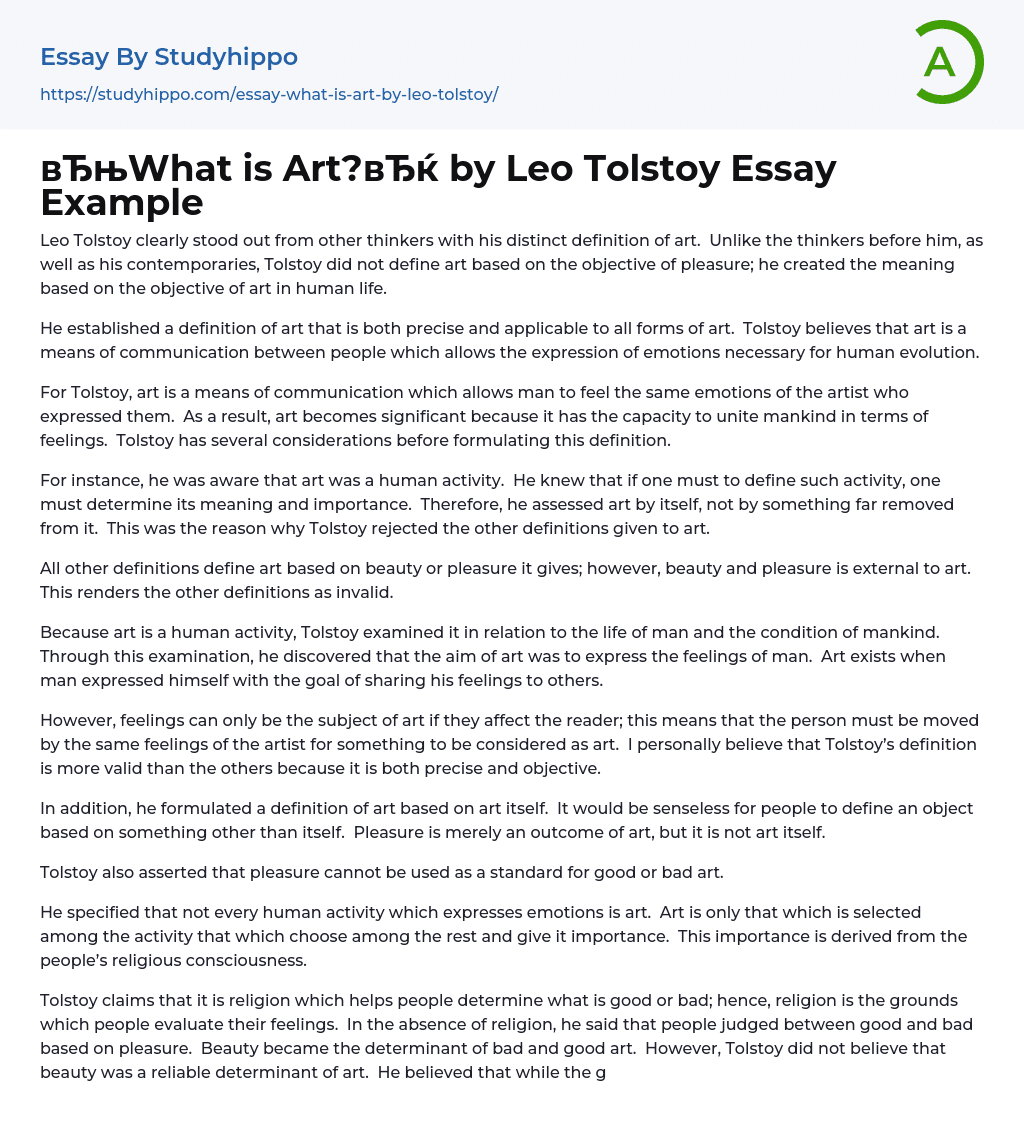Leo Tolstoy clearly stood out from other thinkers with his distinct definition of art. Unlike the thinkers before him, as well as his contemporaries, Tolstoy did not define art based on the objective of pleasure; he created the meaning based on the objective of art in human life.
He established a definition of art that is both precise and applicable to all forms of art. Tolstoy believes that art is a means of communication between people which allows the expression of emotions necessary for human evolution.
For Tolstoy, art is a means of communication which allows man to feel the same emotions of the artist who expressed them. As a result, art becomes significant because it has the capacity to unite mankind in terms of feelings. Tolstoy has several consid
...erations before formulating this definition.
For instance, he was aware that art was a human activity. He knew that if one must to define such activity, one must determine its meaning and importance. Therefore, he assessed art by itself, not by something far removed from it. This was the reason why Tolstoy rejected the other definitions given to art.
All other definitions define art based on beauty or pleasure it gives; however, beauty and pleasure is external to art. This renders the other definitions as invalid.
Because art is a human activity, Tolstoy examined it in relation to the life of man and the condition of mankind. Through this examination, he discovered that the aim of art was to express the feelings of man. Art exists when man expressed himself with the goal of sharing his feelings
to others.
However, feelings can only be the subject of art if they affect the reader; this means that the person must be moved by the same feelings of the artist for something to be considered as art. I personally believe that Tolstoy’s definition is more valid than the others because it is both precise and objective.
In addition, he formulated a definition of art based on art itself. It would be senseless for people to define an object based on something other than itself. Pleasure is merely an outcome of art, but it is not art itself.
Tolstoy also asserted that pleasure cannot be used as a standard for good or bad art.
He specified that not every human activity which expresses emotions is art. Art is only that which is selected among the activity that which choose among the rest and give it importance. This importance is derived from the people’s religious consciousness.
Tolstoy claims that it is religion which helps people determine what is good or bad; hence, religion is the grounds which people evaluate their feelings. In the absence of religion, he said that people judged between good and bad based on pleasure. Beauty became the determinant of bad and good art. However, Tolstoy did not believe that beauty was a reliable determinant of art. He believed that while the good, the true and the beautiful are associated to each other, they are remarkably different.
The beautiful is nothing but that which is pleasurable, while the good is the noblest aim. This was the reason why Tolstoy did not agree with the usage of pleasure
to determine the goodness or badness of art. In my opinion, Tolstoy was justified in his claim against pleasure.
Just like in the case of art’s definition, I believe pleasure is subjective and must not be used to assess art. If art cannot be defined with pleasure as its basis, then naturally art also must not be judged with pleasure as its grounds.
Indeed, Leo Tolstoy had refuted the traditional notions and standards of art. He refused to agree to the definitions of art which used pleasure as its foundation. Also, he disagreed with the usage of pleasure to differentiate good art from bad art. For Tolstoy, art was a means of communication between people which expressed feelings. Leo Tolstoy created his own definition of art and succeeded in justifying it.
Work Cited
Tolstoy, Leo N. “What is Art?” The Nature of Art: An Anthology. 2nd Edition. Ed. Thomas E. Wartenberg. New York: Wadsworth, 2007.
- Christina Rossetti essays
- Emily Dickinson essays
- Ernest Hemingway essays
- Percy Bysshe Shelley essays
- Robert Browning essays
- Robert Louis Stevenson essays
- Seamus Heaney essays
- Carol ann duffy essays
- Anne Bradstreet essays
- Elizabeth Bishop essays
- Peter Skrzynecki essays
- Poets essays
- Robert Frost essays
- Aldous Huxley essays
- Anton Chekhov essays
- Charles Dickens essays
- Edgar Allan Poe essays
- F. Scott Fitzgerald essays
- Harper Lee essays
- Homer essays
- Jane Austen essays
- John Steinbeck essays
- Kurt Vonnegut essays
- Mark Twain essays
- Mary Shelley essays
- Nathaniel Hawthorne essays
- Sophocles essays
- Stephen King essays
- William Shakespeare essays
- Zora Neale Hurston essays
- Amy tan essays
- Virginia woolf essays
- Alice Walker essays
- Chinua Achebe essays
- Sherman Alexie essays
- George Orwell essays
- Sylvia Plath essays
- T. S. Eliot essays
- W. H. Auden essays
- Wilfred owen essays
- William blake essays
- Kate Chopin essays
- Oscar Wilde essays
- Phillis Wheatley essays
- Ray Bradbury essays
- Richard Rodriguez essays
- Walt Whitman essays
- The Tempest essays
- Leonardo Da Vinci essays
- Thomas Hardy essays




